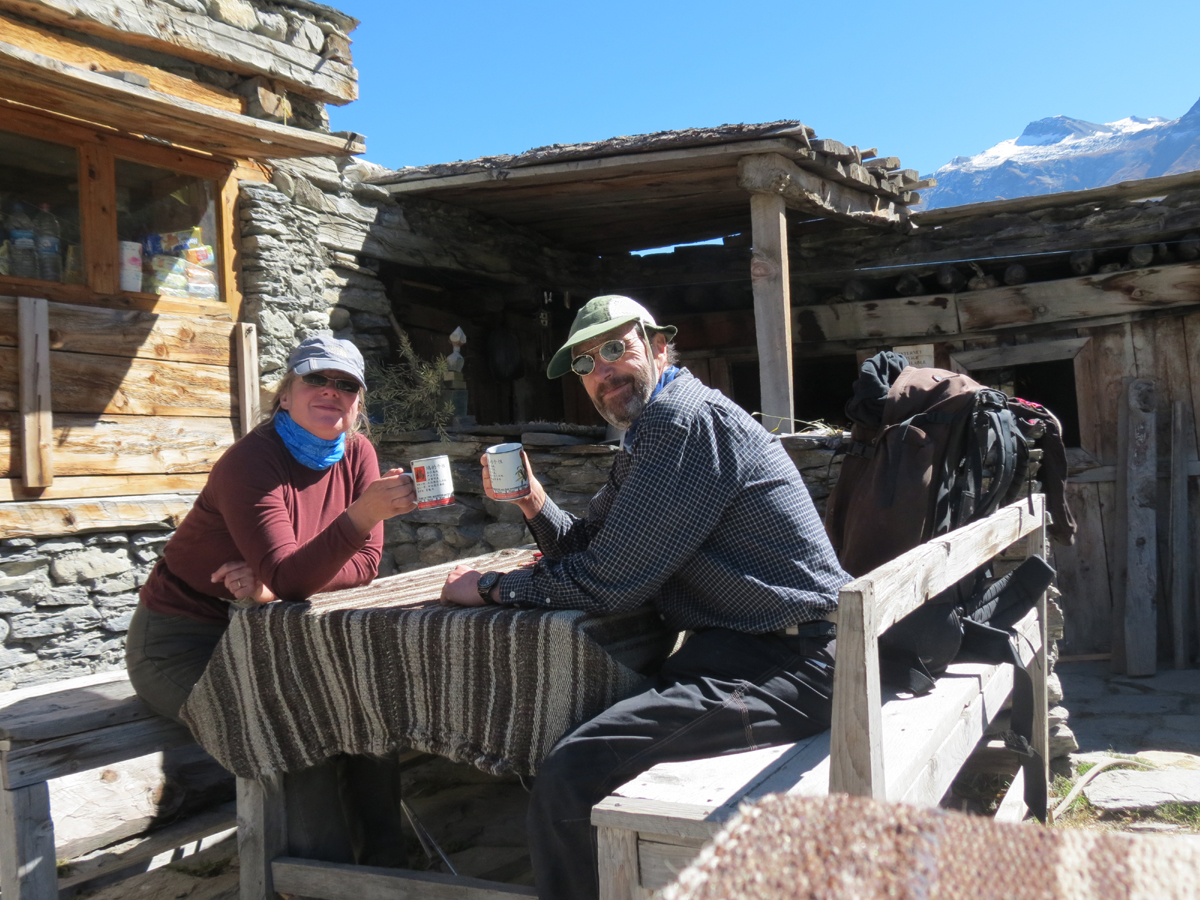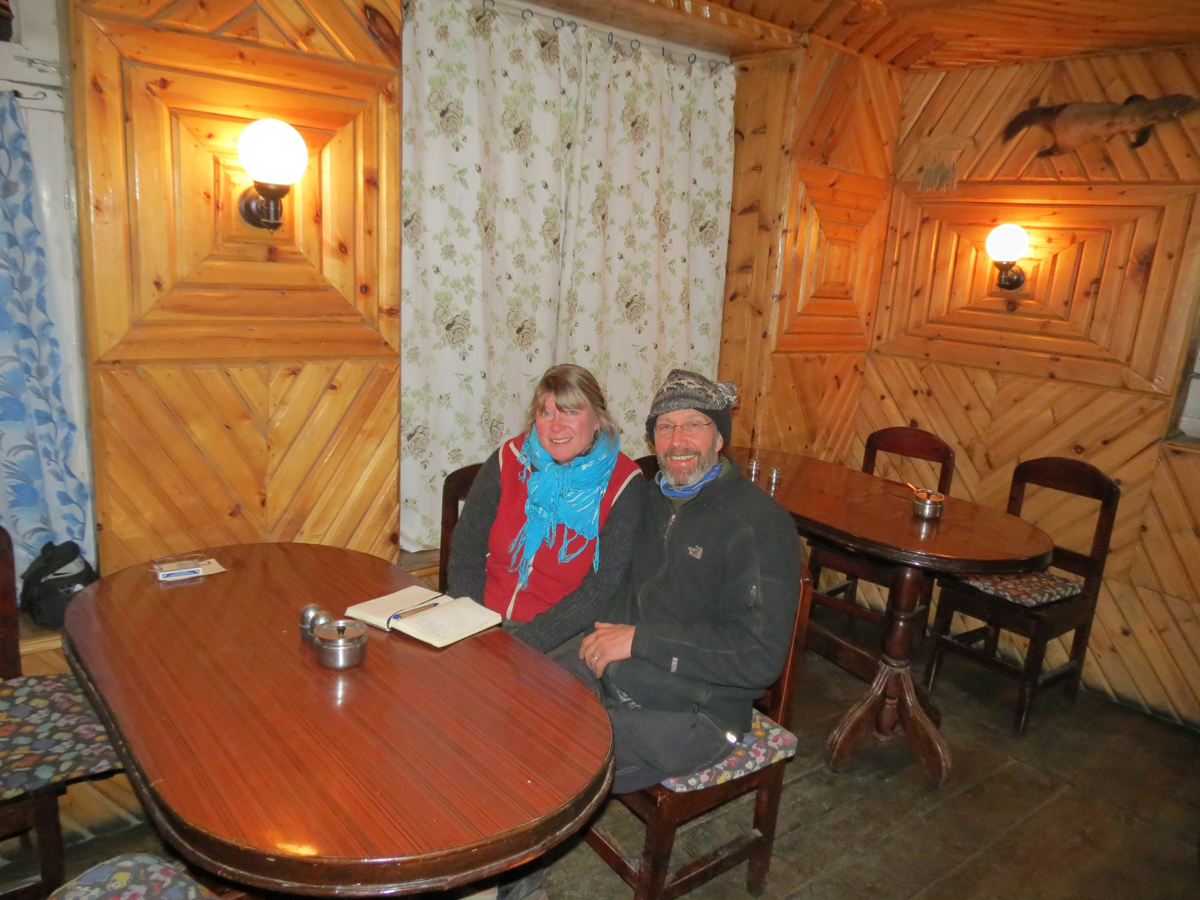Our first visit to Nepal was in 1979. My husband and I had been married for only one year, so it was like a honeymoon trip for us. It was not a usual route like that of now. We entered from the southern Asia route– from Turkey to India– via private bus. We arrived in Nepal in the month of February. We took the long and winding bus ride from Raxaul, India to Kathmandu.
After some days in Kathmandu, we took a bus to Pokhara, which took about 10 hours. From Pokhara we started our hike on foot into the more remote village areas. We used our own map and followed the foot trails of the Annapurna circuit, starting in Pokhara.
Pohkara was completely undeveloped at the time, but very quaint and interesting. We, my husband and I, enjoyed hiking tremendously and ate dal Bhat every day- at that time the only menu choice. We knew this combination of rice and beans was very healthy and the side of greens was probably loaded with iron.
We noticed evidence of poverty in the various villages, but people seemed happy and had great purpose in life. Of the 7 Asian countries we traveled through, we liked Nepal the best! The architecture was fascinating, the religious traditions, the lovely woven fabrics & beautiful handmade jewelry. At that time no one spoke English in Nepal.
Our second visit to Nepal in 1983. We were really excited because of our earlier experiences of being in Nepal. Nepal quickly became one of our favorite countries as we reminisced. Time in Kathmandu in the evening by candlelight was magical near the temples.
We did a longer trek from Pokhara, and I even went swimming in one of the rivers. We loved the simplicity of life, a bucket of hot water for showers, delicious & nutritious goods, the buffalo’s milk yogurt, yak cheese, and the fabulous traditional Nepali music. After many years and many memories of being in Nepal, we hoped to return again in the early 2000's, but civil war broke out and travel was not recommended.
In 2006, we met the first Nepali student in Duluth, Minnesota, our family home. Starting in 2006 we started meeting Nepali graduate students in Duluth at our University of Minnesota, at some Diwali events. Actually the first Nepali person we met here in Duluth was the first Nepali we could speak English with! He was the person that let us know when it was safe again to go back to Nepal.
We did experience the Diwali celebration in Nepal, and were very fortunate to be in a rural area where we were staying with a family at their lodge. That evening small children came to the doorstep and traveled house to house singing and tapping like a drum and holding out a plate for coins. It was beautiful to see tall and short kids, about 10 in each group going door to door much like we do in the states for Halloween. I can almost hear the song they sang back in 1978!
In 2011, we returned to Nepal to make one last trip to this beautiful country. We were not sure if we could still do trekking, which takes a lot of physical energy and strength. We practiced hiking 1-2 miles daily with a plan to do part of the Annapurna Circuit. We were not sure we could handle the trek, but we planned to take 1 day at a time.
We were concerned about any repercussions lingering over the Civil War. We did experience some sad stories from a few of the lodge owners who told us their son had been kidnapped and taken away and killed. This was not how we remembered Nepal, and it was such a sad feeling that this mother had lost her adult son.
The rural people put up with a lot of threats and violence during Maoist movement. In one situation when we stopped for tea, and sat outside on a stone low wall, I noticed the owner had a gun on the shelf. I had never seen a gun in Nepal before and of course seeing a gun always triggers an unsettling feeling in my heart.
We rarely see guns in our state except if someone is going to go hunting, but handguns are just not something that are a part of everyday life. I remember thinking we had to pay attention in case anything bad happened. We needed to be safe.
 Our trek was for 5 days along the Helambu route. We hiked on our own again, without a guide, but with a map & compass. We do a lot of camping in Minnesota, so we knew to bring water purification medicines, sleeping bags, hiking boots, and appropriate clothing. As it was, the Helambu route was quite difficult since roads have interrupted the route in many places and it was difficult to follow the foot trail.
Our trek was for 5 days along the Helambu route. We hiked on our own again, without a guide, but with a map & compass. We do a lot of camping in Minnesota, so we knew to bring water purification medicines, sleeping bags, hiking boots, and appropriate clothing. As it was, the Helambu route was quite difficult since roads have interrupted the route in many places and it was difficult to follow the foot trail.
At one point, we kind of gave up and linked up with a guide and another American that welcomed our company. We had only a couple days left of this route, so we enjoyed the conversations with the American- who was American Indian (Apache) and the guide spoke English and was very informative.
I remember sitting around the little cooking stove at one of the lodges with the lodge owner & his two daughters. We were way out in the middle of nowhere in a very remote place that had taken us 4 days to get to. It was then and there that I realized the lodge owner was not living in isolation at all!
During the course of the evening, 2 French trekkers showed up, a fellow from Australia, and tomorrow, another batch of international trekkers. Everyday, this lodge owner was meeting people from all over the world- just like Grand Central Station. His life, in fact, is much more international than mine!
As much as I had started loving Nepal, I was also consumed by the feelings of doing something for it and to the humble and kind people there. When we flew into Kathmandu, we brought with us 300 pairs of prescription eyeglasses.
One of our former Duluth graduate students from Nepal is now back in Bhaktapur, his home town, as an associate professor. His family had generously started a Health Service program for the rural villages where each year they set up Health Camps to teach the local villagers about good health practices with a focus on eye care, surgeries, and fitting eye glasses. He asked us if we would like to be involved in the eye camp, and I asked him if he could use some donated eyeglasses to give to those that may need them. It was the inspiration of his program that gave us the idea to bring eye glasses to Nepal to be given out at these Eye Camps.
Our Nepalese friend welcomed the idea of having us bring the glasses. The eyeglasses were donated from the Lion’s Club here in Duluth, Minnesota. When people can no longer use their eyeglasses, they can drop them off at any eyeglasses clinic in a special container and then the Lion’s Club will come to pick them up. Sometimes large shipments of eyeglasses go to far away places like Africa or India. So, this is where we were able to get all those eyeglasses for free.
We also brought reading glasses to pass to those in need. At the school I was teaching at, we had our immigrant students wash all of the glasses before I packed them up in a big suitcase to bring to Nepal. We never actually attended the eye camp with our friend in Bhaktapur, as we had made plans to do some trekking for several days. We bought 30 pairs of eyeglasses with us on the trek to seek out people that could use them.
Our American hiking companion was going all the way to Langtang and we gave him 7 pairs of reading glasses to take to the monks where he was going to do some filming.This first 5-6 day trek was so enjoyable and easy for us. Once we had a guide to follow we decided to do a second trek on the Annapurna Circuit for 11 days.

To be continued…..